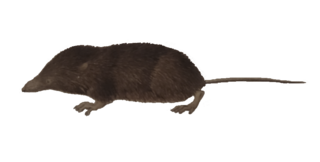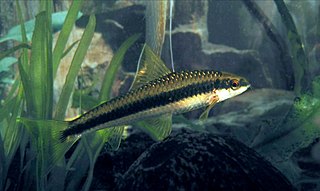
The red garra, also known as the doctor fish or nibble fish, is a species of cyprinid that is native to a wide range of freshwater habitats in subtropical parts of Western Asia. This small fish typically is up to about 14 centimeters in total length, but locally individuals can reach as much as 24 cm (9.5 in).

Garra is a genus of fish in the family Cyprinidae. These fish are one example of the "log suckers", sucker-mouthed barbs and other cyprinids commonly kept in aquaria to keep down algae. The doctor fish of Anatolia and the Middle East belongs in this genus. The majority of the more than 140 species of garras are native to Asia, but about one-fifth of the species are from Africa.
Typhlogarra widdowsoni or Garra widdowsoni, the Iraq blind barb or Haditha cave garra, is a species of cyprinid fish endemic to underground water systems near Haditha in Iraq. Although traditionally placed in its own genus Typhlogarra, this is not supported by genetic evidence, leading to its move to Garra. This cavefish is considered critically endangered because of water extraction, which has lowered the groundwater level. Once abundant, a survey in 2012 found that it now was very rare. Another species from the same place, Caecocypris basimi, may already be extinct. The only other known cavefish in Iraq is Eidinemacheilus proudlovei.

The Himalayan shrew is found in Bhutan, China, India, Myanmar, and Nepal, is currently the only species in the genus Soriculus within the tribe Nectogalini, although the species Chodsigoa and Episoriculus, which occur in southeastern Asia, as well as those of the fossil European genus Asoriculus, were formerly included there.

Labeoninae is a doubtfully distinct subfamily of ray-finned fishes in the family Cyprinidae of order Cypriniformes. They inhabit fresh water and the largest species richness is in the region around southern China, but there are also species elsewhere in Asia, and some members of Garra and Labeo are from Africa. They are a generally very apomorphic group, perhaps the most "advanced" of the Cyprinidae. A common name for these fishes is labeonins or labeoins.
Garra annandalei, the Annandale garra or Tunga garra, is a species of ray-finned fish in the genus Garra. It is found in northern Bengal, Bihar and Assam in India, Nepal, Myanmar and possibly Bhutan where it is found in rocky, clear and fast flowing mountain streams.
Garra bibarbatus is a species of ray-finned fish in the genus Garra from Vietnam.
Garra hughi is an endangered species of ray-finned fish in the genus Garra. It occurs in high mountain streams of the Southern Western Ghats, from the Anamalai Hills, south to the Agasthyamala Hills. The species is a benthopelagic fish, found in mountain streams.
Garra kalakadensis is a species of cyprinid fish in the genus Garra which is endemic to the Western Ghats in India.
Garra magnidiscus is a species of cyprinid fish in the genus Garra. Identified in 2013, Garra m. is found in the Upper Siang district of Arunachal Pradesh where is it is known locally as Ngop. The name magnidiscus refers to a distinctive large adhesive disc found in the posterior region of its mouth.
Garra elongata is a species of ray-finned fish in the genus Garra from Manipur in north eastern India and possibly Myanamar.
Garra tashanensis is a species of ray-finned fish in the genus Garra. This cavefish is endemic to the Tashan Cave located in the Tashan region of Khuzestan Province, Iran.
Garra tamangi is a species of ray-finned fish in the genus Garra described from the Dikrong River at Hoj near NHPC complex, Itanagar, Papum Pare district, Arunachal Pradesh, north eastern India.
Garra lorestanensis is a species of ray-finned fish in the genus Garra Known from the Loven Cave, the natural outlet of a subterranean limestone system of the Zagros Mountains in the Ab-e Sirum or Ab-e Serum Valley near Tang-e Haft railway station, the Tigris River drainage, the Persian Gulf Basin, Lorestan Province, southwestern Iran.
Garra abhoyai is a fish species in the genus Garra endemic to the Chindwin basin in India.
Garra birostris is a fish species in the genus Garra endemic to India.This species reaches a length of 10.2 cm (4.0 in).
Garra incisorbis is a species of cyprinid fish in the genus Garra endemic to the Pearl River Basin in Guangxi, China.
Garra bimaculacauda is a species of cyprinid fish in the genus Garra endemic to Bhutan.
Garra fluviatilis is a species of cyprinid fish in the genus Garra endemic to the Khwae Noi River in Thailand.
Yang Jun-Xing is a Chinese herpetologist and ichthyologist with the Kunming Institute of Zoology. As of 2018, Yang authored 9 species of fish and amphibians.


